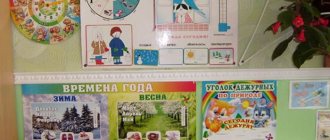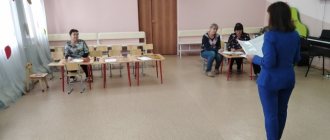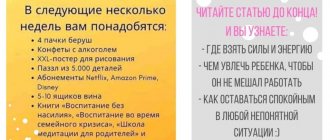List of all notes published on our portal
Includes sections:
- Speech development classes. Lesson notes, GCD
- Open classes. Notes
- Integrated classes. Notes
- Classes to familiarize yourself with the outside world
- TRIZ. Activities and games using TRIZ technologies
- ICT. Abstracts, developments using ICT. The use of information technology in preschool educational institutions
- Psychologist's classes. Notes, GCD, conversations with children
- Museums: notes of classes, excursions, educational activities on the topic of museums
- Maslenitsa. Lesson notes for children
- Lesson notes for the preparatory group
By groups:
- Senior group
- Preparatory group
- Middle group
- Junior group
Showing publications 1-10 of 291358. All sections | Lesson notes, GCD
New
Photo
The best
Final lesson in the middle group “Let’s help the land of smiles” Administration of Ulan-Ude Education Committee MBDOU kindergarten No. 70 “Sun”
Final
lesson in the middle group “Let’s help the land of smiles”
Educator: Demina E.A.
Ulan-Ude April 2020 Final lesson “Let’s help the land of smiles”
Objectives: Educational: - consolidate the ability...
Summary of educational activities for cognitive development in the preparatory group “Journey to the Land of Health” Topic: “Journey to the Land of Health”
Goal: to form preschoolers’ initial ideas about a healthy lifestyle. Objectives: 1. Expand children’s understanding of balanced nutrition, the importance of personal hygiene and physical activity in human life. Develop…
Structure of classes with preschool children
Teaching preschool children
is visually effective. The child acquires new knowledge on the basis of direct perception, when he watches the teacher’s actions, listens to his explanations and instructions, and acts with the didactic material himself.
“Tell me and I’ll forget, show me and I’ll remember, let me do it and I’ll understand.”
(Confucius)
The lesson begins not at the desks, but with the children gathering around the teacher. In younger groups, children can, for example, sit on chairs in a semicircle in front of the teacher.
Lesson structure at a younger age
1. Introductory part. Classes often begin with game elements, surprise moments - the unexpected appearance of toys, things, the arrival of “guests” or fairy-tale plots. This interests and activates the kids. (3 – 4 min)
2. The main part of the lesson. Learning new material or consolidating previously learned material. This stage occurs using a didactic game and working with handouts. (8 – 10 min)
3. Summing up. Be sure to praise the children for the work they have done. (2 minutes)
In the middle of the lesson, you should do a physical training session.
Class structure in middle age.
1. Introductory part. Classes begin with a didactic game, surprise moments, a problem situation, artistic expression (2 - 3 min.)
2. Studying new material (10 - 12 min).
3. Repetition of previously studied material (4 – 6 min).
4. Summing up. In the middle group, at the end of the lesson, the teacher himself sums up the lesson, introducing the children. (“What did we learn new today? What did we talk about? What did we play?”). (2 – 3 min)
After studying new material, it is advisable to conduct a physical training session.
Structure of classes at older ages.
Option 1.
1. Introductory part. Checking children's readiness for class. Creating interest in the lesson (2 - 3 min)
2. Repetition to introduce children to a new topic. A group of children usually sits at desks in twos, facing the teacher, as they work with handouts and develop learning skills. (3 – 5 min.)
3. Consideration of new material. In older groups, it is advisable to use problem situations. (12 – 15 min)
4. Repetition of learned material. (5 – 7 min.)
5. Summing up. In the older group, children draw their own conclusions: “What did you do?”, “What new did you learn?”, “What did you like?” (3 – 4 min.)
After studying new material, you should do a physical training session.
Option 2.
- Organizing time.
- Continuation of work on studying a new topic.
- Continued study of immediately preceding material or its consolidation.
- Repetition of what was previously covered.
- Summarizing.
The gradual increase in complexity of program material and methodological techniques aimed at mastering knowledge and skills allows children to feel success in their work, their growth, and this, in turn, contributes to the development of their increasing interest in their studies.
REMEMBER!
The leading activity in preschool age is play.
. During classes, use didactic, developmental and outdoor games.
Video: lesson notes.
Most of the activities for preschoolers are educational and also contain elements of art, familiarization with the environment, and, of course, physical exercises (dynamic pauses) and games.
Many works are located in several sections of this section at once, since they combine several areas. So, for example, classes in art are a general section, while classes in drawing or modeling are specific categories. However, when publishing, it is advisable to indicate all categories of headings related to your material for a more convenient search. Additionally, we suggest filling out sections that sort notes by topic. Then, when preparing a lesson with your children, you can use ready-made lesson notes. For example, in the “toy topic” section, you can find all activities related to toys in one way or another.
If you want your entry to be included in this section, when publishing, select the “ class notes”
,” and additional subsections.
All sections
Beginning and ending rituals
The presence of rituals for the beginning and end of a lesson is very important when working with preschoolers in groups. Rituals allow you to better organize children, set them up for work, unite them and create the necessary atmosphere. The organizational moment helps children understand where the lesson begins and where it ends.
Mathematics classes for preschoolers aged 6-7 years
Examples of rituals for starting and ending classes:
- “Continue the sentence.” The teacher begins the sentence, and the children sitting opposite take turns completing it. For example, the teacher says: “What I like to eat most is... apples” or “My favorite game is... hide and seek.”
- “Pass the signal!” Children sit or stand in a circle and hold hands. The teacher chooses a beginner, and on command he lightly squeezes the hand of the one standing on the left, and the one next. And so on several times until the “signal” transmission speed becomes as fast as possible.
- “Come on, repeat it!” The teacher demonstrates a movement, pose or facial expression, and the kids must repeat it all together.
- “Today I found out...” This ritual is suitable for ending a lesson. Each child begins the construction of his sentence with this phrase and supplements it with what he remembers most from this lesson.
Morning greeting charges you for the whole day
- Physical education session to the same song or melody. A good option would be to start or end the lesson with the selected musical composition. Thanks to this, it will be easy for kids to record the moment of beginning and ending.
- “What am I?” The essence of this ritual is a short story for each little one about himself. Children are given the opportunity to think a little about what they will say, and, starting with the teacher, each child says a few words about himself. There is no point in carrying out this ritual every day, but by periodically returning to it, you can make it clear to children that some qualities and characteristics of a person remain unchanged for a longer time, while others, on the contrary, change every day.
- “The sea is agitated once...” This well-known children's fun is also suitable for the role of a ritual. It is simple, cheerful, but at the same time requires a certain amount of attention from the participants.
There are a great many variations of these rituals, the list is available to everyone. The teacher needs to choose those that are most suitable for his students and the classes he conducts.
Note! It is important to remember that it is better to use different rituals to start and end classes. It is enough to select a few to start with and a few to finish. This will make it easier for children to record these moments.
Types of classes in preschool educational institutions according to the Federal State Educational Standard
The Federal State Educational Standard did not exclude classical lessons, where the teacher presents and explains the material, gives tasks that the children complete, and then sums up the results. But in addition to this type of activity, the program must include innovative activities:
- Excursion. Depending on the topic and purpose of the lesson, children are taken to a construction site, library, museum, employment exchange, etc.
- Collective creative work (CTD). The guys draw or build together and develop a scenario for the event.
- Labor occupation. Children learn about everyday life in practice: they work in the garden beds and clean the premises.
- A game. Pupils are invited to play at a store or construction site, or an auction. For example, you can offer this option: whoever talks more about a certain item, advertises it better, is the one who buys it.
- Individual creativity. Children are encouraged to become craftsmen and inventors. They create crafts and appliqués from available materials.
- Gatherings. Suitable for studying folklore. Children solve riddles, dance in circles, and sing songs.
- Fairy tale or theater. The entire lesson is organized as a performance and develops along one storyline.
- Interview or press conference. One child appears as the main character, the others as journalists. After the interview, the children write down and sketch what interested them.
- Lesson-help. This is the name for activities aimed at practicing what children are not yet able to do. They are helped by those who have already acquired knowledge or honed a skill. Work is carried out in pairs or groups.
- Story with discussion. Children are given a task, one person answers, others comment and discuss his actions.
- Game "Tour Guide". One child talks about something, other children ask him questions. For example, we can talk about some city or animals listed in the Red Book.
- Research, or problem lesson. The teacher names the problem, and the children look for its solution. For example, you can organize a search for an answer to the question “why study?”
- Experiment. The student is given some object or substance, he does whatever he wants with it, observes changes and records conclusions. It is important to monitor the safety of children during such lessons.
- A story based on pictures. The methodology is simple: children or the teacher draw, and then compose a story based on the images. For example, you can make a drawing-essay about visiting kindergarten or about expectations regarding schooling.
- Competitions and quizzes. You can arrange an activity similar to the game “What? Where? When?" or “Clever or clever.” Or you can divide the children into two teams and discuss some problem from a pros and cons position.
- Projects. This type creates maximum conditions for creativity and cooperation between the teacher and children, and sometimes parents are also involved. The project can be organized on any topic: economics, ecology, art, mathematics, computer technology. This could be design, modeling or manufacturing.
In addition, you can organize games like “one day in the life of a fireman” or “firefighter school”. Children imagine themselves in the role of some person and talk about themselves through songs, dances, pantomime, etc.
It is also important to know what an open lesson in kindergarten is. This is a form of reporting, final lesson, to which parents and other teachers are invited. The teacher demonstrates the children’s achievements and his professional successes, the lesson is focused on the present moment in time, the “here and now” principle. An open lesson can also have another focus: assimilation of knowledge, consolidation of material, a combined lesson.


